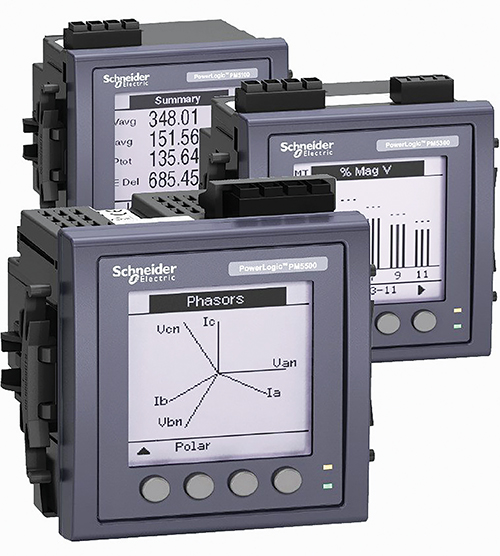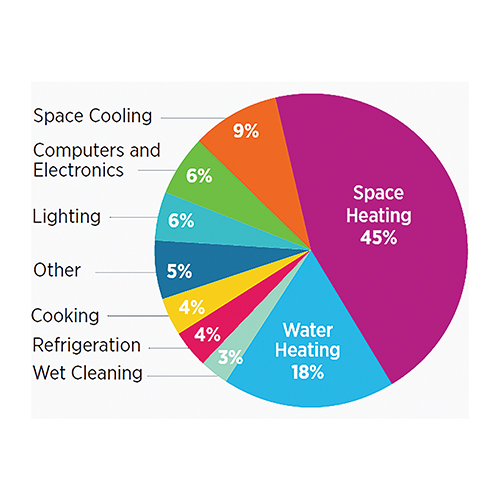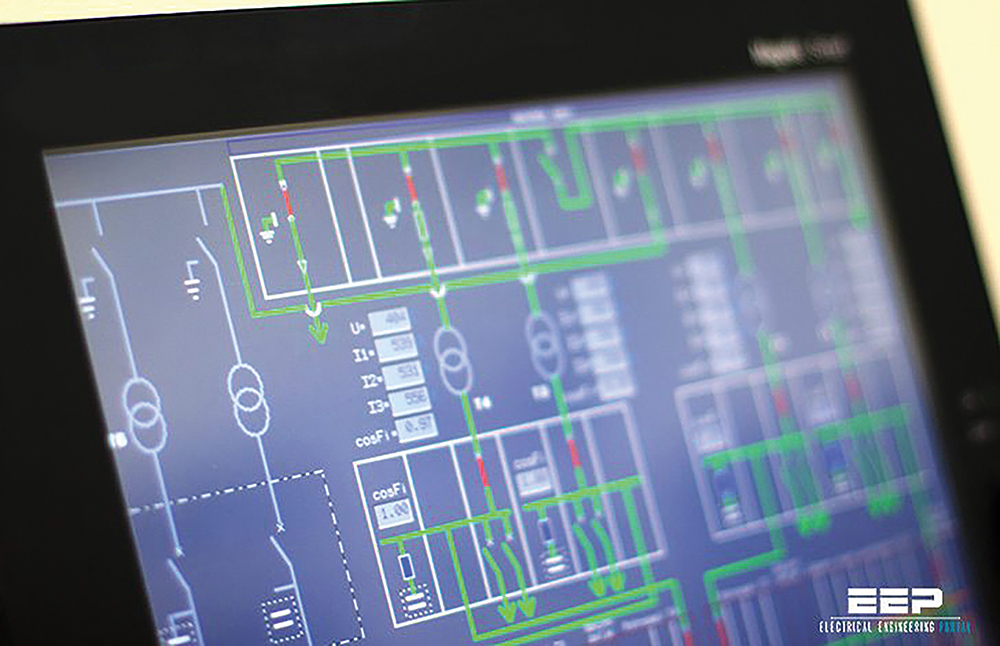Efficiently consumed energy
Energy efficiency in commercial buildings involves providing a given level of performance, cost, quality, availability, and comfort at a minimal level of energy usage throughout the lifecycle of a given asset or process. To achieve a high level of energy efficiency, there are at least six solutions you can apply and which are described below.
Top six solutions to achieve energy efficiency
Energy efficiency involves reducing energy consumption, optimizing energy costs, and improving installation reliability. To achieve a high level of energy efficiency, there are at least six solutions you can apply and which are described below:
- Power measurement
- HVAC control
- Lighting control
- Power factor correction
- Building automation and control systems
- Energy management systems:
- Alarming and event logging
- Asset management optimization
- Energy tariff optimization
- Energy usage analysis
1. Power measurement
This solution allows the field operator to know the electrical flows in the network. The solution also offers some first analysis capability to improve energy use, save money and improve efficiency by:
- Providing raw data for electricity consumption allocation
- Providing real-time power factor and helping the end-user avoid penalties
- Logging peak demand (for the highest product range of this solution).
A basic power measurement solution includes a demand-side or supply-side, high-quality, three-phase, power measurement device that presents data in real time to the field operator.

The basic measurements provided include:
- Current
- Voltage
- Energy
- Power
- Frequency
- Power factor
The simplest form of this solution is a power measurement device on its own that the end user reads or observes when he walks by. At the higher end of this application is a system that includes several power measurement devices (sometimes linked together with a gateway) and a very simple software package.
An advanced power monitoring system provides more accurate information on electric flows to the field’s most demanding users, and it embeds advanced functions to log and sort the main events on the electrical network.
The advanced power monitoring system consists of powerful, accurate power measurement devices connected to power monitoring and control software using the latest communications technologies.
-
HVAC control
Heating, ventilation and air conditioning (HVAC) control applications include products, systems, and services aimed at controlling HVAC equipment in order to:
- Provide required environmental conditions (temperature, air displacement speed, moisture, CO2, etc.) for occupant’s comfort and building efficiency
- Minimize energy consumption
- Reduce other costs, such as operation, maintenance, and repair
Benefits
HVAC can represent up to 70% of energy consumption depending on building type and age as well. Different methods can be combined to save energy costs for HVAC in a range of 5% to 30%:
- Program temperature set point according to occupancy.
- Adapt heating or cooling production power according to real building needs.
- Raise temperature to comfort level when occupant presence is detected.
- Adapt ventilation flow according to occupancy or internal air pollution level
- Recover heating or cooling energy from extracted air.
3. Lighting control
Lighting can represent up to 40% of energy consumption in buildings depending on building types. Lighting control is one of the easiest ways to save energy costs on one of the most common applications. By applying an effective lighting control solution, users can easily save up to 50% on their electricity bill compared to traditional ways.
To achieve lighting control, solutions provide automatic means to optimize lighting based on the three main parameters indicated above (time, intensity and presence), alone or combined. The solutions can begin from very local and small solutions, such as timers, up to very sophisticated, customized but exible, centralized solutions as part of building automation systems.

4. Power factor correction
The power factor (PF) is the ratio of the active power to the apparent power absorbed by the installation: PF = kW / kVA
Power factor correction consists in optimizing the power factor; i.e., setting its value close to (0.92 to 0.95 being a reasonable value). A lower value means that reactive energy must be supplied by the utility network, with consecutive increase of the line demand current.
Power factor correction is generally managed by implementation of capacitor banks.
A power factor correction bank installed close to the load is intended to optimize the power factor at the considered network point, and the flow of reactive power.
Benefits
Reduces the apparent load on the installation.
Reduces the invoice for electrical energy.
Allows the optimization of the customer electrical installation, the utility network, and the power generator.
5. Building automation and control systems
Building Automation and Control Systems (BACS) cover systems and engineering services for control, monitoring, optimization, operation and maintenance of building services:
- Mechanical and electrical equipment (heating, ventilation, air conditioning, lighting, shutters/blinds, power distribution, etc.)
- Security (access control, CCTV, etc.).
Benefits
In buildings, about 80% of energy consumption is in HVAC and lighting.
BACS contribute to energy savings as they can control all building services (HVAC, lighting, blinds & shutters, power, security) and enable their crossed optimization: savings range from 5% to 30% of energy costs.
Operational services enable customers to get the best energy performance from BACS throughout their entire life cycle. This benefit drives customers to get the best possible energy ratings for their buildings.

6. Energy management systems
a. Alarming and event logging
The alarm function provides a means to alert the operator when an event (overcrossing of fixed thresholds, overload, ground fault, etc.) occurs in the electrical network, while the event logging function captures the event with a time-stamp and stores it in an events database.
This information helps the electrical engineering staff to quickly identify and fix problem areas, to analyze and troubleshoot outages and equipment malfunctions, and to take steps to avoid future occurrences.
Possible features of the system include:
- Animated graphical views of the electrical distribution system
- Alarming and notification of key performance and risk indicators
- Sequence of events logging
- Risk and performance audit reporting to determine the cause and effect of any incident that may harm equipment or cause downtime.
Benefits
This application allows customers to react more quickly and efficiently if a critical event occurs on the installation, which can reduce the impact that the event has on the installation. Furthermore, the fault auditing and system analysis tools can help prevent similar events from happening again.
To achieve this function, several tools and architectures should be considered:
- Accurate, time-synchronized power measurement and fault tracking.
- A communication and software architecture to evaluate electrical system operation and to provide a method of notifying the engineer.
- Software tools to organize, filter and present data.

b. Asset management optimization
Regular maintenance and modernization of the electrical network throughout its life cycle is required to efficiently deliver energy to the consumer. Asset management refers to all of the activities to achieve these goals at the best cost compromise.
Benefits
Electrical asset optimization lets the user avoid costly power breakdowns and ensures he receives the required level of power quality:
- Perform the proper maintenance at the optimal time on the correct equipment to ensure performance during the equipment’s life span.
- Ensure a permanent follow-up process for equipment and decide among maintenance, refurbishment, retro for replacement.
- Adjust network architecture to meet the process/activity requirements.
Asset management improves maintenance and operational efficiency because the data management system:
- Captures a description of the installed equipment.
- Logs all data related to maintenance done on the equipment during its life cycle.
- Analyses data coming remotely from the equipment.
An electrical asset management application requires the following services:
- Consulting service to assess the installation and build the plans
- Maintenance (curative and preventive)
- Modernization (new design study and retrofit)
- Monitoring (predictive maintenance)
- Management (information system)
c. Energy tariff optimization
Minimizing risk and maximizing value through securing stable electricity contracts is a high priority for energy managers and executives. By negotiating the most advantageous supply agreements, and investing in schemes to make the best use of available tariffs, customers can optimize the cost of their consumed energy.
Benefits
- Through the analysis of electrical rate structures, the collection of electrical consumption data, and what-if analysis energy managers can make a significant impact on the overall financial contract with utility suppliers.
Knowledge of how a facility’s electrical energy is consumed, used and purchased, provides a huge advantage for the purchaser in contract negotiations. Energy managers leverage this energy procurement analysis and consolidate multiple facilities to reduce the financial impact that electrical energy has across the entire enterprise.
- Depending on the tariffs offered by the suppliers and the loads under the control of the customer, users can reduce energy costs in a variety of ways.
- Peak demand charges can be reduced by detecting an impending peak and shifting non-essential loads to other periods. Peak shaving uses on-site generation to keep loads on-line without setting a new utility peak.
- Customers may also be able to take advantage of tariffs offered by utilities which suffer from a lack of capacity or high marginal cost of production, for example during the hot summer months. A demand curtailment agreement allows the customer to benefit from an attractive energy rate. In exchange, when a utility requests it, the users will reduce their load temporarily.
- Time-of-use rates are another incentive for those customers who can distribute loads to lower-cost times of day and thereby reduce their energy bill.
- Avoiding reactive power charges is another way to optimize cost. Inductive loads such as transformers and motors use not only real power but also reactive power. These types of loads absorb energy during part of the AC cycle, stored in the device’s magnetic or electric field. The energy is then returned to the source during the other part of the cycle. Utilities have to provide capacity to support this reactive power, and increasingly reactive power charges are applied on energy bills.
If your tariff includes reactive power charges, power factor correction is a way to erase this charge from the energy bill.
d. Energy usage analysis
Energy usage analysis provides users with the means to understand their energy consumption based on historical data, usage trends, and benchmarks.
Organizations that lack access to this type of data may miss the most relevant areas for improving energy usage:
- Energy measures that are taken may not be effective, or may be effective at first but decline over time.
- Significant errors in utility bills can be overlooked.
- Without clear data, accountability for energy used tends to be poor, and behavior may run against the organization’s interests.
Benefits
Strategies and actions for energy usage analysis run from the simplest to the most sophisticated:
- Basic energy measurement for all relevant utilities (water, air, gas, electricity, steam, emissions) will allow the user to identify the most relevant areas for improving energy usage and verify the effective impact of energy measures.
- Use of analytical software to perform comparative calculations and show trends further enhances the user’s ability to identify savings areas and assess results of actions.
- Cost allocation report allows the user to verify utility billing accuracy and drive accountability in every level of his organization. By providing ownership of electricity costs to the appropriate level in an organization, it incites energy users to wise management, which results in lower overall energy costs.
- Sub-billing allows the owner of a building or facility to charge or invoice each internal user for their effective electricity consumption, thus giving them ownership of their electricity costs and motivation to use energy wisely.
Owners can also maximize the value of electrical and related assets used to supply tenants and ensure the cost of providing those services is returned. An owner can reduce the overall energy usage for a building by 8 to 0 %, by holding each tenant accountable for their energy costs.
Sources:
URL: http:// electrical-engineering-portal.com/solutions-energy-efficiency-buildings
Reference: Combining protection and measurement in LV by Schneider Electric











Find Us on Socials